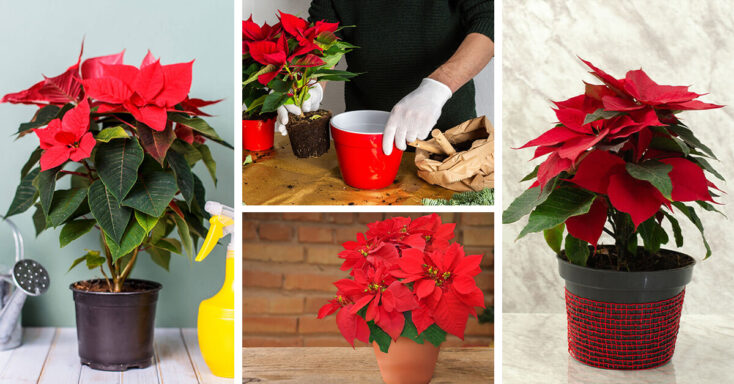Brightening winter homes with its vibrant reds and greens, the poinsettia is a festive favorite. Native to Mexico, this radiant plant isn’t just a pretty face; its star-shaped leaves tell tales of Christmas legends.
Whether dressing up holiday tables or serving as a thoughtful gift, poinsettias bring cheer to any room. Dive in to discover more about this seasonal stunner!
Key Takeaways
- Poinsettias are popular holiday decorations. Originally a green shrub, they are trained to grow as potted plants.
- They thrive at temperatures between 60-70 F and require protection from cold and direct heat.
- Poinsettia needs bright, indirect light with 6 hours of tanning time; east-facing windows are best.
- Over 100 varieties exist with varied colors, patterns, and appearances. Burgundy, Christmas Season Pink, Glace, Ice Punch, and Winter Rose are just some of the examples.
- The main diseases are bacterial soft rot, Rhizoctonia Stem Rot, and Pythium root rot.
- The most common pests are whiteflies, thrips, spider mites, and mealybugs.
What is poinsettia?
Poinsettia starts out green. As shorter winter days arrive, the flowers emerge. But wait… it’s not really a flower at all. Instead, the poinsettia is a small shrub that master gardeners trained to grow as potted plants.
When you think of the holidays, the vision of glorious decorations come to mind, including poinsettias poised graciously around staircases, on tables, and a dozen other spots where they bring color and a celebratory feel.
We have Joel Poinsett (there’s the name!) to thank for our enjoyment of poinsettia. He introduced them to the U.S., being a passionate botanist. Interesting tidbit; Mr. Poinsett co-founded the Smithsonian Institute!
In any case, now that poinsettia come in tidy pots, it makes it far easier to learn how to grow and care for them.
Poinsettia’s flowers are by far the star of this plant’s showiness. They begin as clustered buds in buttery yellow at the center. The leaf modifies, turning color in response to the buds (cyathia) growing. It is best to buy a poinsettia at the juncture before the buds open for longevity.
The most popular color among poinsettias is red, making up about three-quarters of annual sales. White comes in second place, followed by pink ranking third.
“A symbol of hope and goodwill, the poinsettia is a wonderful plant to have in your home during the holidays.” – Eden Alexander
Basic Poinsettia Care
Most poinsettia do not live for long. To care for them and extend their longevity, start with protecting them on the way home. A few minutes of exposure to 50 F and lower causes wilting. At home, keep them away from the heater or air conditioner vents. The prime temperature for your plant is between 60-70 F.
Find a bright area with indirect light during the day. Poinsettias need 6 hours of tanning time with just enough shade to avoid sunburn. East-facing windows are ideal.
If you live in an area with cold winters, pull your poinsettia plant away from the window a bit. No part of the plant should touch the cold glass. Even short periods can hamper plant health.
You’ll be reading more about watering poinsettias in this article. The basic rule is avoiding over-watering at all costs. Make sure your plant dries out between treatments to avoid root rot. A little mist is good for the flower, as it increases humidity.
When your poinsettia blooms, you need no fertilizer. You can augment the soil afterward if you’re planning to keep them growing after the holidays.
While poinsettias look lovely in pure green, the colorful blossoms are the real winners. Getting a poinsettia to rebloom is not an effortless task, nor one for the faint of heart.
Begin once the flowers fade by fertilizing the plant. Keep the plant in proper lighting and moderate water intake. By mid-February, it’s time to check your plant for any signs of insects. If the plant looks thin and long, cut it back 5 inches. One month later, prune the plant of any faded or dried leaves.
You’ll prune again on Memorial Day, taking 3 inches off each leaf to help your plant spread. There’s yet more pruning in early July. Make sure the plant receives at least six hours (or more) of direct light daily until new growth begins.
At the end of September, your poinsettia needs 16 hours of true darkness followed by 8 hours of light. Keep the temperature hovering around 60F. Rotate the plant a little each day so each side gets light.
After Thanksgiving, discontinue the dark treatment. Your plant can go into a spot where it gets direct light. Now, all you have to do is water and watch. If you’re lucky, your plant will reward your efforts with colors soon.
Poinsettia Pining: What Does Your Indoor Plant Need?
Poinsettias have similar needs to all holiday plants. Keep them clear of cold temperatures and drafts. Note: Your fireplace can bring in cold drafts. Too much heat isn’t great, either. Stand them clear of space heaters. Temperature fluctuations are not friendly to poinsettia.
Take a look at your window areas by night. Do any of them glow with streetlamps? If so, steer your poinsettia clear. These plants need dark nights, so the streetlamp disrupts the normal blooming cycle.
Periodically, your poinsettia requires transplanting, usually in late spring. Find a container that has a diameter 3 inches larger than its current pot with suitable drainage. Do not reuse the current soil. Rather, fill the new container with a rich organic mix. Once moved, keep the soil moist but not wet.
Toxic or Not? While there are some symptoms caused by poinsettia consumption, the ASPCA says the plant’s toxicity is way overrated. It may irritate the stomach, causing vomiting or the mouth. Use gloves when working with the plant as some people have sensitivity to the white sap, causing rashes.
Choosing Poinsettias for Your Home
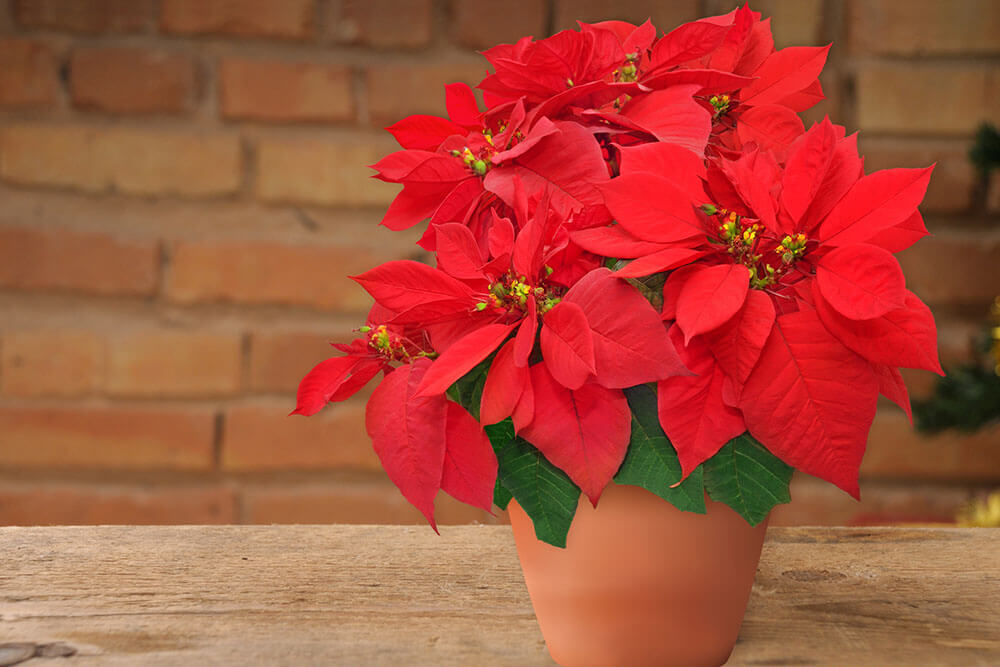
Just when you thought it would be as simple as red, white, or pink, you find out that there are more than 100 varieties of poinsettia. That number is pretty daunting. This list provides plants with different colors, patterns, and overall appearances. While limited, it’s a good place to start thinking about what kind of poinsettia you want for your home.
- Burgundy: Like a fine wine, the burgundy poinsettia has rich tones resounding with a sense of luxury. Against any jewel-toned decorations, this pops. Add a few ribbons just for fun.
- Christmas Season Pink: These are impressive flowers, larger than some. The pink is medium, almost a blush. Christmas Season poinsettias are 6 inches tall and wide, perfect for smaller spaces.
- Glace: Put your sunglasses on. The Glace poinsettia boasts large, bright white flowers. Think elegance plus. Average height 18 inches.
- Ice Punch: The color of this poinsettia makes you wish it were a beverage. The red foliage has blush spots, creating a marbled look. They start flowering in mid-November. Size-wise, you can get one from five inches to 12 inches tall.
- Marco Polo: The Maro Polo sports a frosty salmon color with a touch of marbling. The soft white interiors and bright red accents make it quite showy.
- Mars Pink: A suitable name for an other-worldly pink poinsettia. The interior of the flower is dark pink, slowly paling to light pink notes at the farthest side. Add dark green leaves, and what’s not to like?
- Peppermint Twist: A crowd-pleasing plan. There’s a certain charm about Peppermint twist poinsettias. At first, the leaf ends remain green. Then the pink chimes in with light fuchsia stripes, looking like (as you guessed) peppermint candy.
- Peterstar Marble: This is a dainty, sophisticated poinsettia. It features pink centers surrounded by margins of creamy white. Easy cyathium measures about ½ inch.
- Shimmer Surprise: This poinsettia looks as if an impassioned painter took to brush. The lovely bright red petals each have splattered splashes of white, randomly spaced and placed. Bears similarities to Sonora White Glitter.
- Super mini Winter Rose Red: When you’re looking for size diversity, the mini winter rose red might just be the plant for you. This poinsettia is dwarfed and can make for striking table displays with traditional red hues.
- Tapestry: Nature wove together the colors of this poinsettia perfectly. The flowers are green, cream, burgundy, and red. The broader color array gives you more decorating options.
- Winter Rose: When you think of a dashing swashbuckler, a winter rose should adorn his collar. It’s curly and creamy white, making it stand out unapologetically from the green backdrop. This is a long-lasting poinsettia variety, often still bearing flowers in March.
Fitting in Any Scheme: Poinsettias come in so many sizes, colors, and patterns that you should be able to find one perfect for your celebration theme. Some poinsettias look like roses, while you might find purple petals. Note that colors like blue and purple come from spray paint applied to cream-colored bases.
Watering Methods for Poinsettia
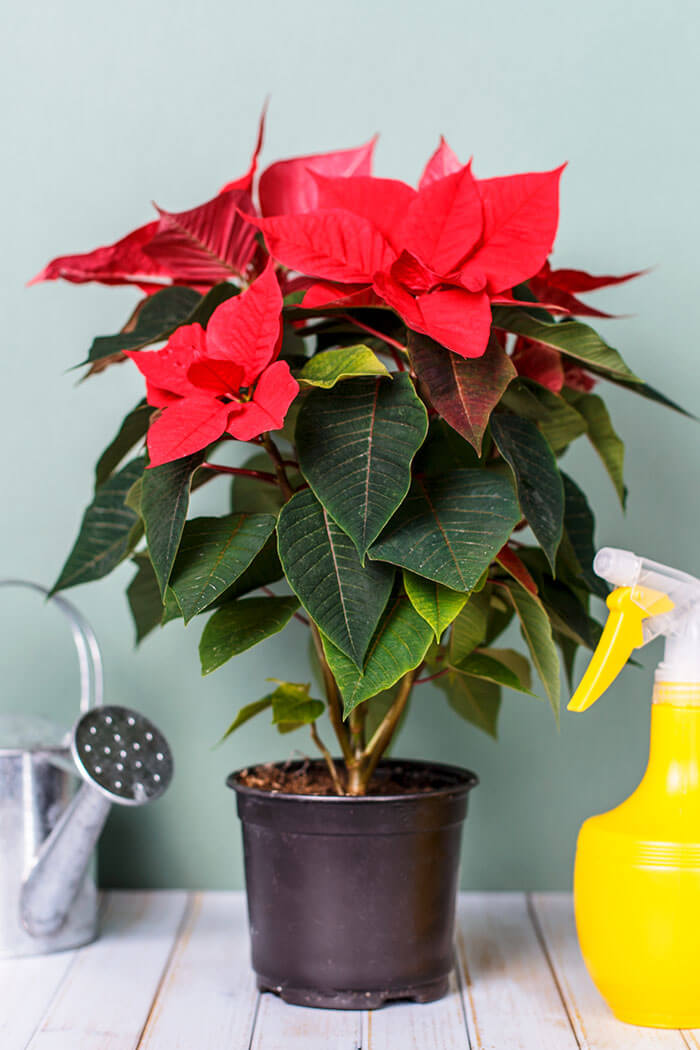
When you get your new poinsettia home, check the container immediately. If it has no drainage hole, you need to transplant it into a pot that has one or more. It doesn’t take long for root rot to set in when the soil is soggy.
Foiled Again: The decorative foil is pretty, but it’s not necessarily good for your poinsettia. It can hold water. Take it off, and do your own decorating, leaving the drain holes clear.
Once a poinsettia’s soil has dried out, take the whole plant to our kitchen sink. It’s about to get a shower. Use the water sprayer to saturate the plant. This has the additional advantage of knocking some pests completely off, sending them down the drain.
When you see drops coming out of the drainage hole (more than one is best), stop. Leave it for a while so it drains (otherwise, you’ll drip-drop through the house.
Use room temperature (lukewarm) water when the plant is ready for more moisture. You can mist the plant periodically to help with humidity.
There is a Mexican story that explains poinsettia’s association with Christmas. There was a young girl who had little means to bring flowers to the church altar on Holy Night, as other children would.
Everyone told her that the thought mattered. Feeling reassured and following that advice, Eve carefully gathered pretty weeds from the roadside and made them into a bouquet. Upon arrival at the church, something amazing happened. The flowers transformed into a colorful flower, red poinsettia.
Poinsettia Potting and Repotting
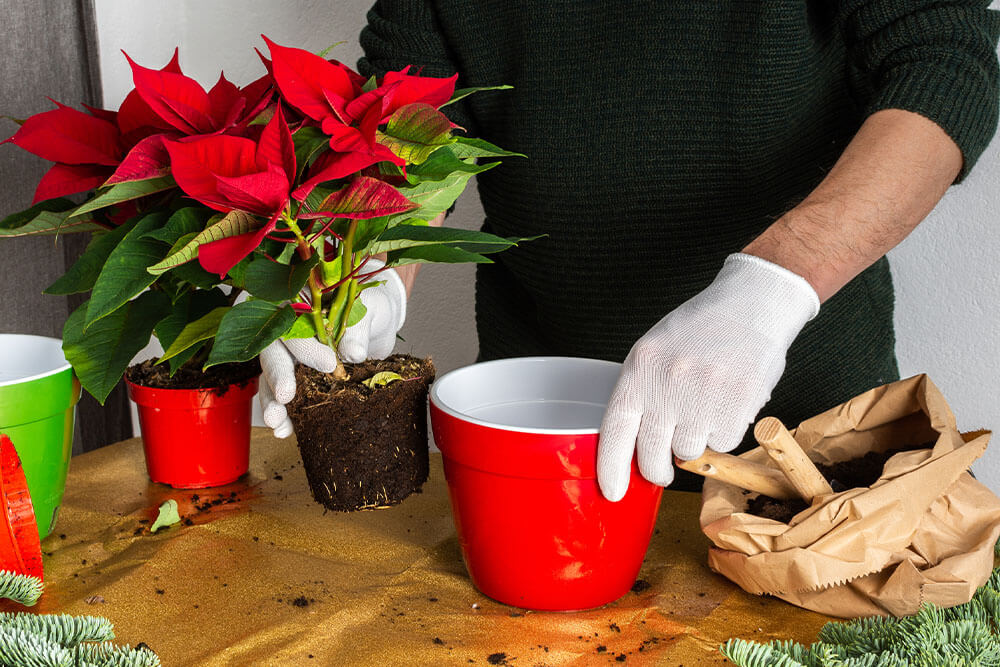
Since you have to transfer your plant from the garden center’s container, you’ll be learning how to pot and repot at the same time (cool! Multitasking). Buy a pot that’s two inches wider and deeper than that container.
It will give your plant’s roots plenty of room to spread out. Check for drainage holes. If it doesn’t have them, find one that does. By the way, avoid plastic containers if possible. Terracotta is best.
How do you know when to repot? Watch for these signs.
- Cracks developing in the pot
- New shoots develop (March to May)
- Overly thirsty plant
- Roots grow out of the drain holes
- White crust looking like salt accumulates on the soil’s surface
A Tidy Transfer
Repotting can get messy. Take your plant to your garage or a space outside. Lay down newspaper to catch loose soil. Put enough soil in the container so that the plant sits about an inch from the rim.
Place the pot on its side. Tap to loosen the soil. Hopefully, the plant tips out by itself. If not, give it a gentle tug at the base. Now put it in the new crock adding more soil as needed. Provide a first watering but don’t drown it.
Your plant may not look so well after repotting. It has a slight case of shock. Just continue giving it TLC.
Poinsettias have numerous nicknames. They include the Christmas Flower, Christmas Star, Lobster Flower, Winter Rose, Flores de Nochebuena (flowers of Holy Night), Mexican flame leaf, the crown of Andes, and Atakurk Flower (this name is from Turkey, where the founder’s name was Atakurk.
Tips on Pruning and Maintenance for Indoor Poinsettia
In their native tropical home (Central America and Mexico), poinsettias can grow 15 feet tall (yes, really!). Mind you, it is, after all, a shrub. Thankfully, your houseplant is nowhere near that size.
To maintain the image of a small bush, keep the poinsettia trimmed to 6 inches above the main stem. If you remove the tops of the main shoots, larger flowers form. If you want the poinsettia to look more like a Bonsai tree, clip off the shoots from the main stem, leaving the top in place. Continue pruning the side shoots to maintain this appearance.
After flowering is over (usually February or March), cut off all the dead foliage with clean shears. Remember, you should never be overly aggressive with poinsettia. Never prune more than 30% of the plant.
Some people find the white sap leaking from poinsettias irritating when cut. Wear gloves to avoid prickliness. If the sap leaks onto the plant, take a damp rag and wipe it out. Apparently, the leaves have not reached an accord with sap drippings.
Come November, stop trimming. The shorter days and slightly darker skies create a change in poinsettias, where they start to flower.
Interesting Uses for Poinsettia: From 1400-1600 CE, Aztecs used the leaves of poinsettia as a dye for their clothing fabric. It turns out purple. They also used it in cosmetics and as part of the healer’s kit.
Poinsettia Blossoming and Resting Times
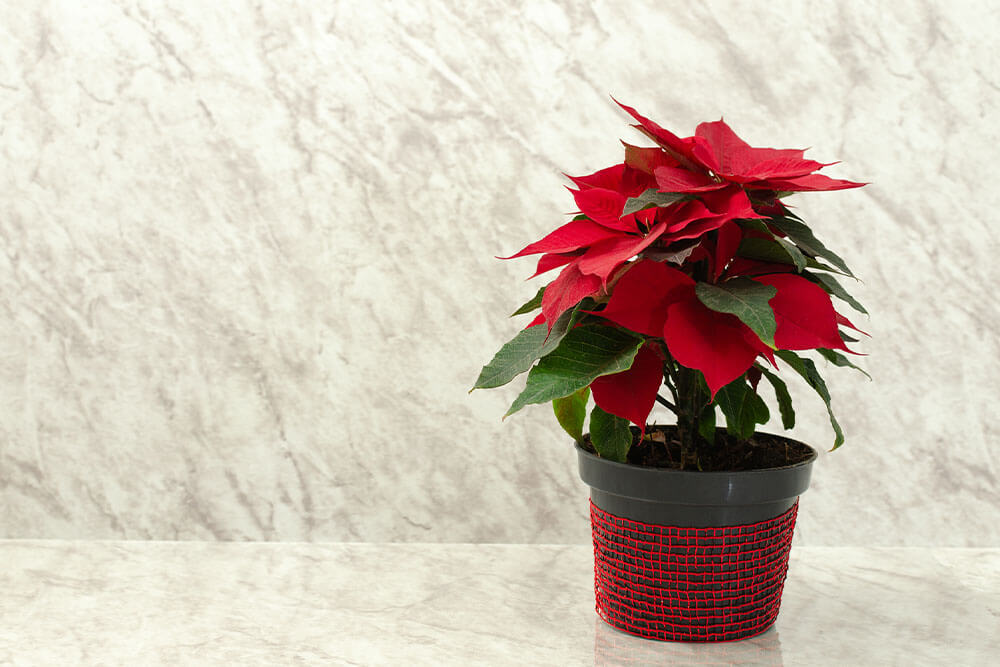
Master Gardeners designed the poinsettia to be a holiday plant. This is why you rarely see the plant after Christmas. If you choose to keep your plant, you can follow a schedule to keep it healthy and even blossom again next year.
Come April, reduce watering. Just make sure you provide enough water to keep the stems from withering. Place the planter where the temperature hovers around 60 F.
April: This is the rest period for your poinsettia. To lull it into its dormant phase, gradually decrease watering and allow the soil to dry out a bit – water enough to keep the stems from withering. Put it in a cool place, around 60 F, and let it rest. At the end of the Month, snip the stems to 5” and transplant it into a container 1” bigger than the first filled with fresh soil.
Start watering regularly again, give the plant some fertilizer, and return it to its happy sunny location. If you’re having a warm summer, you can put your poinsettia outside somewhere with both sun and shade.
Should your plant look leggy, pinch back the branches. August is the time to start shaping your poinsettia. When October rolls around, make sure your plant receives 8 hours of daylight followed by 12-14 hours of complete darkness.
In November, your poinsettia rewards your steadfast effort. The colors will slowly appear until the entire plant shines.
The spelling police have had their hands full with poinsettia. Some people drop the I at the end of the word. Other folks toss in a T (poinsettia). The flower isn’t only misspelled but also mispronounced. Dictionaries say that “poin-SET-uh “and “point-SET-ee-uh” are acceptable ways of pronouncing this word. However, flower shop owners will tell you that their costumes frequently insert the T (point-SET-ee-ah).
Indoor Poinsettia: Common Pests and Diseases
High on the list of troublemakers for poinsettias are Whiteflies, which have become somewhat pesticide resistant. Thrips appear, but only because they migrated from another plant. Spider mites, gnats, and mealybugs are also in the overall picture.
Plant Infestation Symptoms
- Fungus gnats damage roots, stunting the plant’s growth. When you examine the plant, it may look like root rot. Yellow sticky cards can capture them; they like bright colors.
- Mealybugs turn poinsettia leaves yellow. Overall, the plant looks unhappy. Apply insecticidal soap.
- Mites cause leaf bronzing. Spider mites leave behind the telltale sign of small white webs. Try Neem Oil.
- Thrips cause direct leaf damage. Yellow sticky cards, like those made for gnats, are a way to capture adults.
- Whitefly symptoms: These tiny white flies lead to mottled or yellowing leaves. The newest leaves are their first target. You may mis-evaluate the problem as stress or nutritional issues.
Diseases
Bacterial soft rot, Rhizoctonia Stem Rot, and Pythium root rots are the primary disease in poinsettia. Bacterial soft rot may cause a sudden collapse or wilting of the leaves and stem. Your best bet is getting a new plant (pesticides don’t work).
Rhizoctonia manifests as cancers at the soil line. The disease spreads more when there are high temperatures. Apply fungicide.
Pythium Root Rot makes your plant look wilted, and it shows signs of stunted growth. Fungicides are effective. With Bacterial Soft Rot, the plants experience a sudden collapse of the main steam and leaves. It’s a bacterial disease difficult to cure.
Poinsettia Honors: December 12th is National Poinsettia Day. The tradition began in the mid-1800s. The chosen date commemorates the death of Mr. Poinsett (12/12/1851), the originator of poinsettias.
Troubleshooting Common Poinsettia Problems
If your poinsettia clippings smell bad, your plant may be struggling with incorrect pH levels or bacterial rot. It’s worth testing your soil for current nutrients.
Poinsettias are temperamental about temperature. If they’re exposed to cold, particularly a swift change in temperature, the plant may lose leaves. If you are taking a plant from a store, cover it with a bag for protection.
In your home, a room that stays between 55F to 75 F. That’s the “just right” zone. Be on the lookout for air conditioner and heating vents. And while it might appear lovely on the lintel, when you burn wood in your fireplace, move the poinsettia to a safer location.
When poinsettias lose leaves, check several things. Is the plant near a drafty space or one that’s too hot? How is the water level? Leaf drop often occurs with overwatering.
Color is King: During the holidays, people in the United States buy a staggering 34 million plants (or more). 75% of those poinsettias are red. White takes 2nd place, and pink comes in 3rd.
Frequently Asked Questions About Poinsettia Care
Are poinsettias hard to keep alive?
Not really, especially when you start with a healthy plant. When you shop for a poinsettia, never buy one that has shedding leaves. Look to see if the yellow flower buds are closed. When all seems good, get your plant home quickly. Chilly air makes them grumpy.
How long will a potted poinsettia last?
Under ideal conditions, poinsettias last for two to three months. You can continue caring for the plant afterward until about April.
When should I put my poinsettia in the dark?
Placing your poinsettia in the dark is part of the flowering phase. The plant needs 14 hours of complete darkness with temperatures hovering at 60-70 degrees F. Continue so doing until colors start showing. Once established, move your poinsettia to a sunny area for 6 hours daily.
How often do you water a poinsettia?
If you pick up your poinsettia pot and it seems light, it’s likely time to water it. The easiest method is putting it in the sink, giving it a thorough wash, and letting it drain. Once drops stop coming out the bottom, move them back to their home.
Do poinsettias need sun?
Being a tropical plant, poinsettia is definitely a sun lover. Give it 6 hours of bright indirect light daily.
Why is my poinsettia losing leaves?
Poinsettias can be picky. If they experience a sudden change, it’s not uncommon that stress follows. The leaves may wilt or fall off. Just give it proper care, and it should bounce back. Other potential causes include dry air, not enough water.
Summary
While many think poinsettia is only a holiday plant, its green leaves can continue adoring your home so long as you care for it properly. If you purchase a poinsettia that hasn’t blossomed yet, you can enjoy watching the colors emerge just in time for festivities.
Better still, poinsettia is an easy plant to grow, with just a few items to which to pay attention for care. Enjoy your bright holiday season with your poinsettia as a centerpiece.

